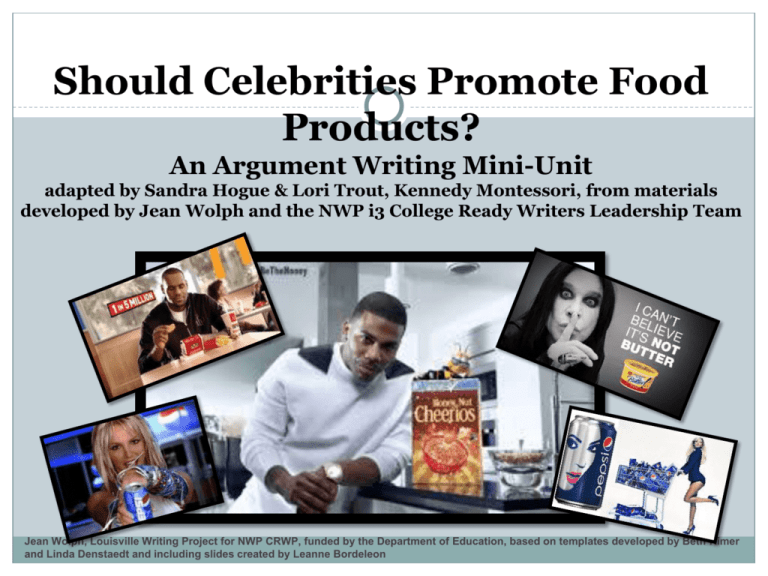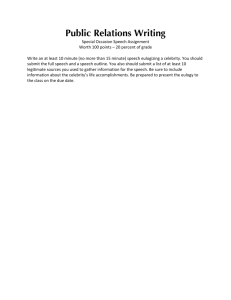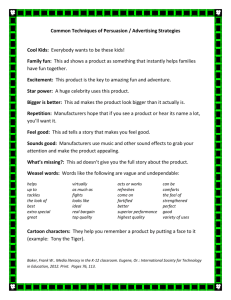
Should Celebrities Promote Food
Products?
An Argument Writing Mini-Unit
adapted by Sandra Hogue & Lori Trout, Kennedy Montessori, from materials
developed by Jean Wolph and the NWP i3 College Ready Writers Leadership Team
Jean Wolph, Louisville Writing Project for NWP CRWP, funded by the Department of Education, based on templates developed by Beth Rimer
and Linda Denstaedt and including slides created by Leanne Bordeleon
Should celebrities
promote food
products?
What do you notice?
Which would you purchase? Why?
Turn to a partner.
Discuss what you wrote.
At first I thought …
Now I think …
If both of you had exactly the same idea,
describe different experiences that you
have had.
What do you notice about these 2
advertisements?
Who is endorsing the product?
Does the endorser change whether you or
others would purchase the product?
Turn to a partner.
Discuss what you wrote.
At first I thought …
Now I think …
If both of you had exactly the same idea,
describe different experiences that you
have had.
WATCH THE NEWS!
The first few minutes of this video clip shows
the results of research about kids and celebrity
endorsements.
http://www.cbsnews.com/news/kids-may-be-highlyinfluenced-by-athletes-endorsement-of-unhealthyfoods/
At first I thought …
Now I think …
Turn to a partner.
Discuss what you wrote.
READ ALOUD!
Let’s learn more about the research.
Kids may be highly influenced by athletes' endorsement of unhealthy
foods
By MICHELLE CASTILLOCBS NEWSOctober 7, 2013, 12:55 PM
It's hard to watch any sporting event without seeing a commercial featuring a star
athlete such as Peyton Manning or LeBron James.
Now, a study published on Oct. 7 in Pediatrics shows that a lot of the foods they
are promoting are unhealthy, concerning pediatricians because adolescents are
among their primary viewers.
"Professional athletes wouldn't endorse tobacco today because it would be a
liability for them," lead study author Marie Bragg, a doctoral candidate in
psychology at Yale University, told the Globe and Mail. "We're hoping one day that
the same would be true for unhealthy foods.“
READ ALOUD!
Kids may be highly influenced by athletes' endorsement of unhealthy
foods--continued
It's not surprising that many endorsement deals come from the food industry, say
the authors, especially because previous studies have shown consumers feel that
that food products promoted by professional athletes are generally healthier. Their
study, however, found that was not the case.
Researchers looked at 512 brands endorsed by 100 different athletes during 2010.
While sporting goods or apparel made up 28.3 percent of the products they
pitched, food and beverage items were a close second (23.8 percent). Other
consumer goods came in third (10.9 percent).
Forty-four food and beverage brands, 62 food products and 46 beverages were
represented in 2010 by an athlete. About 79 percent of the food items were
energy-dense, meaning they were high in calories for how much they weighed,
and nutrient poor, as measured by a healthfulness score of each product. Around
93.4 percent of the beverages had 100 percent of their calories come from added
sugar.
READ ALOUD!
Kids may be highly influenced by athletes' endorsement of unhealthy
foods--continued
LeBron James, Peyton Manning and Serena Williams were the athletes most likely
to have a sponsorship deal with a consumer company. James and Manning
promoted the most caloric and nutrient-poor food.
"The striking irony here is that you have some of the world's most physically fit
athletes promoting really unhealthy foods," Bragg said.
The researchers noted Manning earned $10 million a year to promote products
including Papa John's, Gatorade, Oreo and Wheaties while James' endorsements
included McDonald's and Bubblicious Gum.
The researchers warned that this form of advertising was especially worrisome,
since children between 12 and 17 years old were the ones who were viewing the
TV commercials the most.
READ ALOUD!
Kids may be highly influenced by athletes' endorsement of unhealthy
foods--continued
"Professional athletes should be aware of the health value of the products they are
endorsing, and should use their status and celebrity to promote healthy messages
to youth," the authors said in a press release.
The Center for Science in the Public Interest (CSPI) reported in March that 97
percent of kids' meals at 34 top chains did not meet recommended standards for
nutrition. In June,, the World Health Organization urged companies to take
responsibility when marketing unhealthy food to children. At the time, the agency
pushed for stronger rules when it came to trying to sell food products to kids.
CSPI executive director Michael F. Jacobson said in a statement that it was
"discouraging" to see many celebrity athletes promote unhealthy junk food. By
having such prominent spokespeople, he felt the ads made it seem that junk food
was associated with athletic.
READ ALOUD!
Kids may be highly influenced by athletes' endorsement of unhealthy
foods--continued
"Of course the opposite is true. Drinking Sprite and eating at McDonald's is not
going to make you play basketball like LeBron James any more than smoking
cigarettes will make you ride a horse like the Marlboro Man," Jacobson added.
Kathleen Keller, an assistant professor in the department of health and nutritional
science at Penn State, said to Reuters that one way to protect children against
these unhealthy messages is for parents to teach kids about how advertising
works. Even if kids aren't watching TV at home, they are being exposed to
advertising wherever they go.
"Within your home you can really teach your kids from a young age about what the
purpose of marketing is, what the purpose of advertising is," Keller said.
© 2013 CBS Interactive Inc. All Rights Reserved.
• Thought-provoking
quotes from our article
are on each poster.
• Travel in teams
around the room to
read and respond--in
silence. Only the
markers are “talking”.
• Revisit each chart.
Read and add new
thinking.
• Return to your
notebook to capture
new thinking. First I
thought… Now I
think…
Exploring Research with
“Marker Talks”
PRACTICING CLAIMS
●We’ll use an article we’ve already
read (“Is it OK to Sneak Food
into the Movies?).
●Then we’ll write a claim using
this framework:
[WHO] should [DO WHAT] because [WHY].
Note: You may also use “should not” instead of “should.”
Remember this
information from
the article?
Professor Richard
McKenzie reports
that there is an
806% markup on
movie theater
popcorn – a large
bucket averages
$8.15 but costs
only 90 cents to
make.
Brainstorming
Claims
for MOVIE
THEATER
SNACKS
[WHO] should [DO WHAT]
because [WHY].
What do we think? Do they
charge too much? Is it okay
because they need to make
money? Who is helped by
this practice? Who is hurt?
Does it matter?
Sample Note
Card Claim
for MOVIE
THEATER
SNACKS
[WHO] should [DO WHAT]
because [WHY].
THEATERS should CUT
SNACK PRICES because
THEY MAKE TOO MUCH
PROFIT.
Sample Note
Card Claim
for MOVIE
THEATER
SNACKS
[WHO] should [DO WHAT]
because [WHY].
MOVIE THEATERS should
REDUCE CONCESSION
PRICES because THE MARK
UP IS EXCESSIVE.
Sample Note
Card Claim
for MOVIE
THEATER
SNACKS
OR
Because [WHY], [WHO]
should [DO WHAT] .
Because THEATERS NEED
TO MAKE A PROFIT,
CUSTOMERS should
ACCEPT MOVIE FOOD
PRICES.
Sample Note
Card Claim
for MOVIE
THEATER
SNACKS
OR
[WHO] should not [DO
WHAT] because [WHY].
MOVIEGOERS should not
COMPLAIN ABOUT
CONCESSION PRICES
because THEY CAN ALWAYS
EAT BEFOREHAND.
Let’s
MAKE
A
CLAIM.
Ready to try it with
our CELEBRITY
food advertising
issue?
Exit Slip—Notecard Claim
● Read over your writing so
SAMPLES:
Celebrity endorsements are
more harmful than helpful
because __________
far and use the note card to
write a claim about the
issue: Should celebrities
endorse products?
● How might you qualify (or
limit) your claim?
Because research shows ___,
we should ___.
NWP CRWP funded by the Department of Education
Share your note card claim
with a neighbor.
Linda Denstaedt for NWP CRWP, funded by the Department of Education
PQP: Praise,
Question, Polish
Let’s
IMPROVE
OUR
CLAIMS.
Does your partner’s claim have
WHO, WHAT, and WHY?
If not, talk through how to
change the claim.
NOW REVISE! Let’s be clear
and get right to the point.
NEXT:
Using your
copy of the
article,
highlight the
evidence that
you think is
most
convincing.
THEN we’ll learn two ways that
writers USE evidence to support
their opinion or CLAIM.
Ways to Use Sources
Illustrating – When writers use
specific examples or facts from a
text to support what they want
to say.
Examples:
●
Pillars provide the
support needed to hold
together the structure.
Resources “to think
about: anecdotes,
images, scenarios, data.”
(Harris)
●
●
●
●
●
●
“_____ argues that ______.”
“_____ claims that ______”
“_____ acknowledges that ______”
“_____ emphasizes that ______”
“_____ tells the story of ______ “
“_____ reports that ______”
“_____ believes that ______”
Leeanne Bordelon, NSU Writing Project, 2014
Example of Illustrating
from “The Early Bird Gets the Bad Grade” by Nancy
Kalish:
“When high schools in Fayette County in Kentucky
delayed their start times to 8:30 a.m., the number of
teenagers involved in car crashes dropped, even as
they rose in the state.”
Linda Denstaedt, i3 Leadership Team, National Writing Project
Ways to Use Sources
● Authorizing – When writers
quote an expert or use an
authority to support their claims.
Dr. Joseph Bauxbaum, a researcher at the Mount Sinai
School of Medicine, found …
According to Susan Smith, principal of a school which
encourages student cell phone use, …
A study conducted by the Gulf Coast Center for Law &
Policy Center, a non-profit organization which monitors
environmental issues, revealed that …
Leeanne Bordelon, NSU Writing Project, 2014
Example of Authorizing
from “High schools with late start times help teens
but bus schedules and after-school can conflict”
[“T]he focus on logistics is frustrating for
Heather Macintosh, spokeswoman for a
national organization called Start School
Later…. “What is the priority?” she said. “It
should be education, health and safety.”
Linda Denstaedt, i3 Leadership Team, National Writing Project
First, Let’s
● Re-read your notes & previous writing and
learning on the celebrities and advertising.
○
○
○
○
○
○
○
Picture & writing response
Chalk Talks & writing response
Discussion, Discussion, Discussion
Video and writing response
Highlighted article
Notecard claim
Using Sources – Supporting, Authorizing
!
SELECTING EVIDENCE &
CONNECTING IT TO THE CLAIM
●We’ll go back to that article we’ve
already read (“Is it OK to Sneak
Food into the Movies?).
●We’ll select a quote as evidence.
●We’ll paraphrase it (put it into our
own words).
●Then we’ll practice what is called
COMMENTING (talking about)
the facts we’ve found to support
our claim.
Let’s read
this
together.
What do we
notice?
Let’s read
another
example.
What do we
notice?
Let’s read
one more
example.
What do we
notice?
Quote:
Now let’s try
it with our
new topic,
celebrity
endorsements.
Draw this
chart in your
notebook.
(Copy the quote you have chosen HERE)
Source:
(List the title, author, publication and date
HERE)
PARAPHRASE
CONNECTION
(Explain what the
quote means HERE.)
(How can you help
readers see the
RELEVANCE of this
evidence to your claim?
Share your evidence and
connection with a
neighbor.
Add any new ideas to your
notes.
Linda Denstaedt for NWP CRWP, funded by the Department of Education
Continue
this process
with 2-4
more pieces
of evidence.
Quote: Copy the quote you have chosen HERE
Source: List the title, author, publication and date HERE
PARAPHRASE
CONNECTION
Explain what the quote means HERE.
How can you help readers see the
RELEVANCE of this evidence to your claim?
Tell us HERE.
Revisiting Authorizing …
● Authorizing – When writers
quote an expert or use an
authority to support their claims.
Dr. Joseph Bauxbaum, a researcher at the Mount Sinai
School of Medicine, found …
According to Susan Smith, principal of a school which
encourages student cell phone use, …
A study conducted by the Gulf Coast Center for Law &
Policy Center, a non-profit organization which monitors
environmental issues, revealed that …
Leeanne Bordelon, NSU Writing Project, 2014
Example of Authorizing
from “High schools with late start times help teens
but bus schedules and after-school can conflict”
[“T]he focus on logistics is frustrating for
Heather Macintosh, spokeswoman for a
national organization called Start School
Later…. “What is the priority?” she said. “It
should be education, health and safety.”
Linda Denstaedt, i3 Leadership Team, National Writing Project
Using a Source to Authorize a Main
Argument
●Explore your notes and article for one authority that effectively
substantiates your claim.
● Try two or three sentence stems to capture the argument.
According to the National Safety
Bureau, …
A research scientist at the University of
Louisville, Dr. A. Ford, concluded …
The non-profit organization PETA
conducted a study of over 10 million…
Share each of the examples you
are using AUTHORIZING to
support your claim.
Use your partner’s feedback and
your own reflection to improve how
you share the source’s expertise.
NWP CRWP, funded by the Department of Education
Let’s
!
● Let’s Review our notes & previous writing on the
celebrities and advertising.
○
○
○
○
○
○
○
○
Picture & writing response
Chalk Talks & writing response
Discussion, Discussion, Discussion
Video writing
Highlighted article
Claim notecard
Evidence and Commentary to support our claim
Then we’ll write a guided essay to pull
together what we think!
The 40-Minute Kernel Essay
Attention
grabber
lead and
my claim
on the
Issue
Here's
what I’ve
learned
But this fact
really
convinces
me
I now
believe
The 40-Minute Kernel Essay
3 minutes
Attention
grabber
lead and
my claim
on the
Issue
Write an introduction that
provides an interesting detail
about celebrity endorsements to
grab the reader’s attention.
Then state your claim on the
issue of celebrity endorsements.
The 40-Minute Kernel Essay
● 4 minutes
Select 2-3 pieces of evidence that
provide information to support your
claim.
Here's what
I’ve learned
● 10 minutes
State a reason you believe this claim.
Insert evidence using sentence
starters to write what you’ve learned
about the issue of celebrity
endorsements. Connect and explain
how the evidence supports your claim.
The 40-Minute Kernel Essay
● 3 minutes
But this
fact really
convinces
me
Identify 1-2 pieces of evidence that
seem most convincing--maybe a fact
from research or a quote from an
authority.
● 10 minutes
State the reason this fact or quote
seems most important. Introduce the
evidence with a sentence starter like
“According to…” Explain how this
evidence supports your claim.
The 40-Minute Kernel Essay
3 minutes
I now
believe
Write a final few sentences as a
conclusion, perhaps restating
your claim.
Searching for Ways You Used Sources
● Trade papers with a partner.
● Partners read and code the ways the writer used
sources in the margin.
● Search draft for examples of
○ Illustrating= I
○ Authorizing= A
DISCUSS: What have we learned about using sources
during this mini-unit? How can we use these ideas in
other writing experiences, including on-demand
testing?





